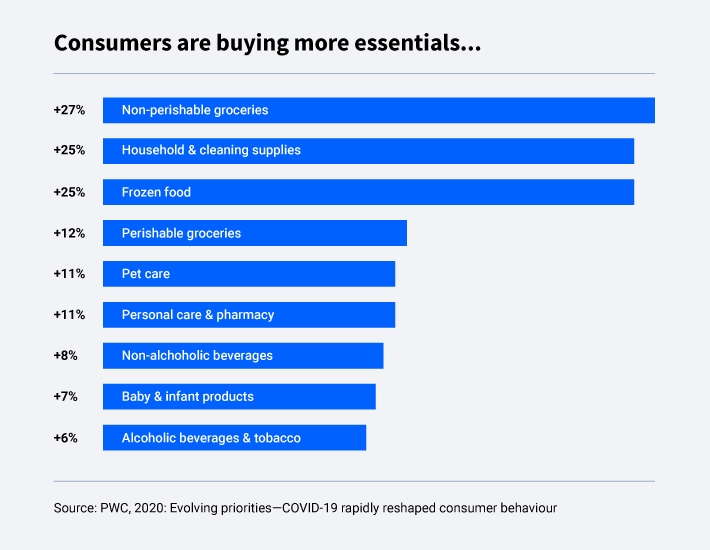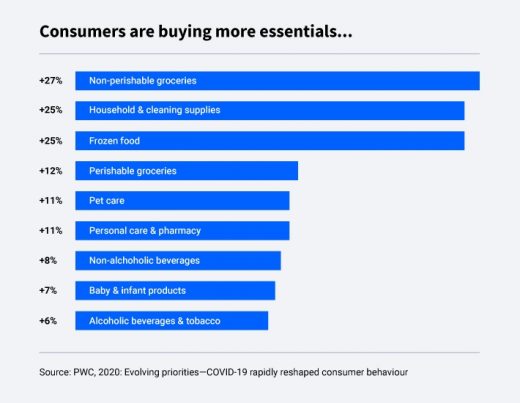A Look at 2020 and Beyond: How Trends and Insights are Reshaping Industries
All around the world, consumers have been settling into newly adopted habits, routines, and ways of thinking—the ‘new normal.’ People and businesses made the necessary adjustments to effectively shelter-in-place, and that includes a major shift and focus to online activity.
Some of the trends that emerged in 2020 are not entirely new. Many people were already working from home and in recent years, digital consumption was seeing a significant rise with greater accessibility to technology and content. Industry leaders have taken the opportunity to examine current processes from supply chain, to manufacturing, to point of sale to see what is working—and to rethink processes that are not. As marketers, we need to pay close attention to these evolving consumer behaviours and trends and pivot our strategies accordingly. We have outlined the 3 evolving consumer trends to help you get started.
Shift to Essential Purchases
The pandemic has had an impact on many people’s finances whether it is from job loss or decrease of paid hours or the prolonged period of financial uncertainty. People in general have become more mindful of how they spend their money and will continue to do so. They are buying items with immediate utility in their daily life—shifting their category spending—and are more willing to trade down to less expensive products.

With that said, marketers should not decrease or stop advertising efforts just because their desired consumer’s purchasing priority has shifted. Instead, making adjustments like aligning your messaging with their needs can be very impactful—providing a sense of community and hope that everyone is in it together. Most often, during these uncertain times, experienced marketers will strategically implement the opposite of what their instincts are—to fight the fear and build a bold growth strategy instead.
Shift to Supporting Local
Through these uncertain times, communities have come together to support each other. With continued pressure on household finances, shifts in behaviour also mean a shift in priorities. People are reevaluating and deciding what product or services to keep and what to remove—50% of consumers are willing to try new brands or alternative products that offer both better value and convenience.
Fifty-seven percent of buyers seek out local, independently owned businesses to support. To speak to these interested buyers, leverage digital marketing efforts to communicate with your local community. Stay transparent and keep them informed—you want to proactively reach out and engage with new prospects. Consumers crave relevant and personalized messaging, pivoting your strategy to include localized creatives can set you apart from your competitors.
Shift to Digital
The accelerated shift to digital in a very short period of time has pushed multiple industries forward. Government stay-at-home mandates also mean that consumers have more leisure time. People are turning to digital platforms to stay connected with their family and friends and to seek out entertainment. Consumers are adopting shopping online with either home delivery or curbside pick up. Companies are embracing the new virtual workforce. Students and teachers are adapting virtual tools to learn and teach. It is very clear that digital is on the rise, and it doesn’t appear to be slowing down.
Throughout this year, all generations have adapted to digital means—leveling out the technology gaps between generations. As a result, there has been an increase in online content consumption. On average a U.S. consumer spends about 7 hours and 31 minutes on digital media consumption compared to the 6 hours and 43 minute average from last year. But let’s quickly zoom into the baby boomers. Although they were the pioneers of adopting home computers, they were also a generation that had slower adoption rates for new technologies and would still prefer to shop in-store. However, amidst the pandemic, the sheer need for interaction was a factor that motivated them to increase their digital usage and this year alone 47% of baby boomers have increased their spending online.
This is a very important year for brands to use marketing efforts to learn and listen to the needs of their consumers. They need to be present online to not only stay top of mind and relevant but also to maintain the momentum of their marketing efforts prior to COVID-19. In a Kantar survey, 77% of respondents wanted advertisers to illustrate how their brand can be helpful in the new normal. Reframing your strategy to ensure your brand is there at every touchpoint of your consumer’s journey and keeping them in the loop will help you build trust and give them confidence.
Business & Finance Articles on Business 2 Community
(14)


